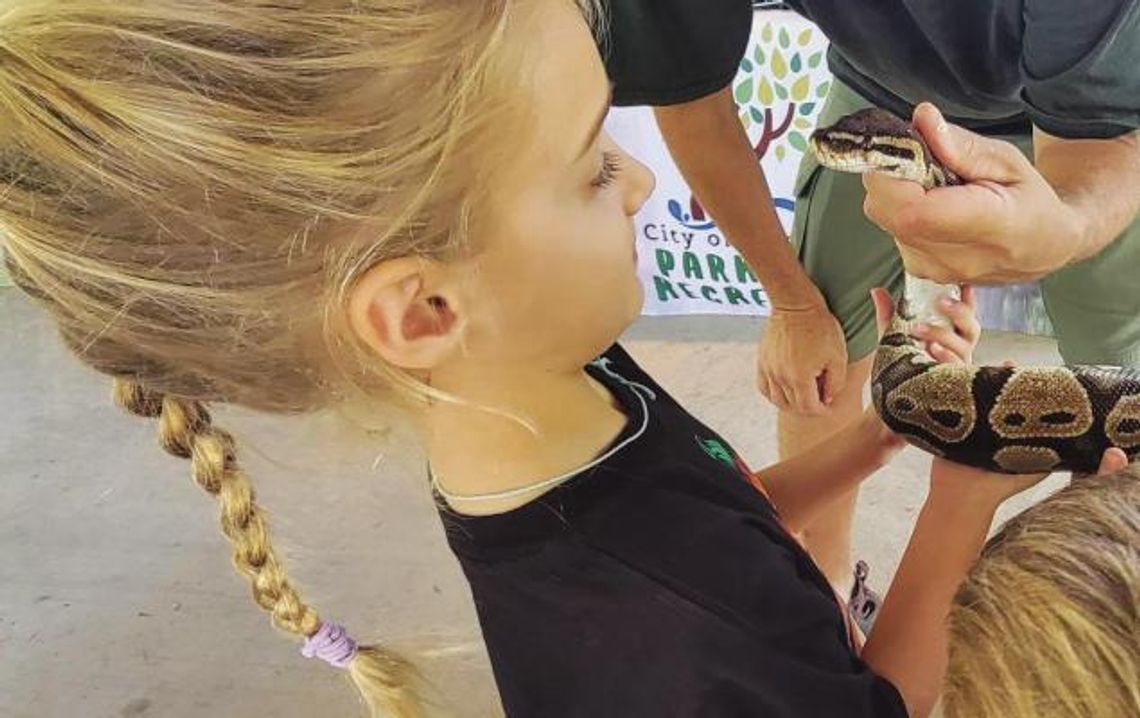Love them or hate them, everyone has an opinion on snakes.
These slithering creatures have been roaming the earth for millions years and have been adapting to an ever changing environment.
Yet despite living in the internet age, people still have questions about snakes.
Some range from the simple question of “What should I do when I encounter a snake in the wild?” to the life saving question of “How do I tell the difference between a venomous snake and a non-venomous snake?”
Those were the questions that were answered at Blue Hole Regional Park’s event “All about Snakes.”
As program director, Nik Farrell explained the importance of why snakes are so vital to the environment. It is a message that he feels needs to be spread while also giving guests a hands-on experience.
“The event was informing individuals about how important snakes are to our ecosystem, their lives, their general biology and to begin to break down the negative stigma of snakes,” Farrell said. “To assist in breaking down this stigma, we invited speaker David Womer to bring his snakes so people could hold and interact with them in a controlled environment.”
One of the biggest misnomers is the saying “The only good snake is a dead snake” when in fact many snakes contribute to keeping the ecosystem in balance.
When talking about venomous snakes and what to do when a person encounters one, Texas Parks and Wildlife says the majority of snake bites that do happen can be attributed to the creature attacking in self defense rather than outright trying to bite someone.
“It is important to remember that not every snake is venomous, and that, while the very mention of the word often sends chills up the spine of many people, snakes do have an important role in our Texas ecosystem.” TPWD said “Their contribution in controlling rodents can hardly be understated. Equally important is an understanding that envenomation is a defensive mechanism for the snake. Snakes don’t hunt humans. Bites are usually a result of the snake being surprised or cornered, or from someone handling snakes.”
One of the biggest challenges when encountering a snake in the wild is knowing if a snake is venomous or not venomous.
There are four types of venomous snakes that make their home here in the Lone Star State.
Perhaps the most famous is the rattlesnake, known for its distinctive rattle on their tail to warn predators and humans to stay away. There are nine different species of rattlesnakes living in the state alone.
Copperheads are also famous venomous snakes known for their distinctive red-brown color pattern that helps them blend in with their surroundings.
Cottonmouths or Water Moccasins are a venomous type of water snake known for their all white mouths that show when threatened.
The fourth type of venomous snake is one that is rarely seen: the Texas Coral Snake.
Known for its distinctive yellow, red, and black striping pattern, this colorful snake is often confused with the Mexican Milk Snake or the Scarlet Kingsnake due to their similar color patterns.
Though the saying “Red touch yellow kill a fellow, Red touch black lucky Jack” is helpful in identifying the version of coral snakes found locally, it is still best to avoid a snake whether it is venomous or not. “Learning the difference between venomous and non-venomous can be difficult or near impossible to tell just by looking at a snake (especially if you don’t know what type of snake it is),” Farrel said. “Having a general knowledge about the common venomous and non-venomous snakes in your area is good as it may ease some nerves if you encounter a snake. It’s also important to remember that snakes do not prey on humans and often attack when they have been surprised or feel threatened.”
To learn more about programs Blue Hole Regional Park has to offer and where to sign up at, visit their website at www.cityofwimberley. com/202/Blue-Hole-Regional- Park. For more information about venomous and non-venomous snakes, visit https://tpwd.texas. gov/education/resources/ texas-junior-naturalists/ snakes-alive/venomous- texas-snakes.







